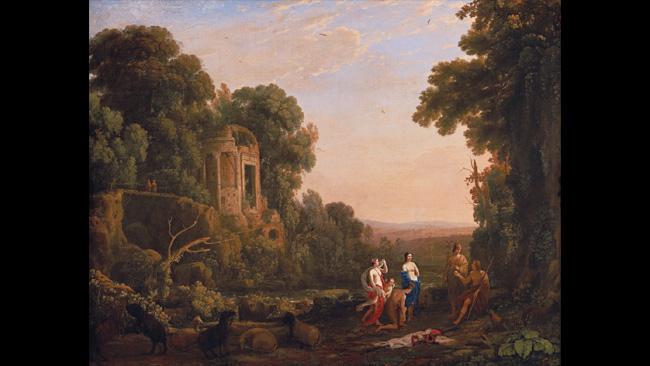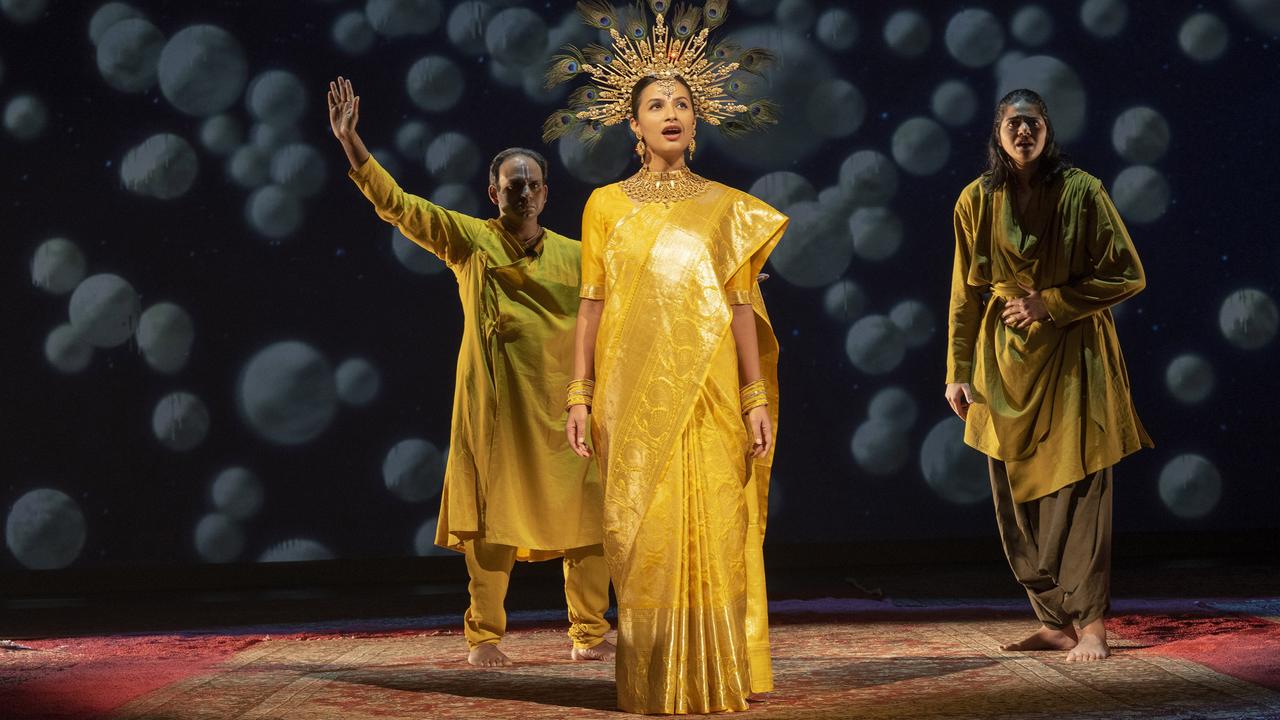Claude Lorrain's enchanting outside vision
CLAUDE Lorrain's luminosity and love of nature is celebrated in an exhibition of his drawings, etches and paintings in Frankfurt.

CLAUDE Gellee was born in 1600 or 1604-05 in what was then the independent duchy of Lorraine, to the east of France.
The duchy largely had been spared the horrors of the religious wars that had engulfed France in the late 16th century, and so remained a flourishing artistic centre while France itself was devastated and artistically a backwater. Lorraine produced the brilliant printmakers Jacques Callot and Jacques Bellange, and above all the slightly later Georges de la Tour, who lived through the French invasion of the duchy in 1633.
Claude travelled to Rome as a very young man, apparently as a pastry cook, but his talent for painting soon manifested itself and he was taught architectural painting by Agostino Tassi. He learnt from older northern contemporaries such as Paul Bril, for landscape had been considered something of a Flemish specialty in Rome until its adoption by Annibale Carracci and by important followers such as Domenichino, elevating its status and preparing the way for Claude and Nicolas Poussin.
Living among the group of northern painters, Claude was given the name of his country of origin, a common habit in this city of foreigners: Michelangelo Merisi, for example, was known as Caravaggio, from the town of his birth. Henceforth Claude was and always remained Claude Lorrain - or Claudio Lorenese - to his contemporaries in Rome. Relatively little is known about his life, but it seems to have been uneventful, entirely dedicated to painting; he never married but adopted a little girl who was probably his daughter by a maidservant.
He achieved success early: by the 1630s he was painting for the pope and for princely patrons. In 1637, as forgeries of his work had already begun to circulate, he began to keep a register of his paintings: after each one was completed, he would make a detailed drawing of it in what he called the Liber veritatis, the book of truth.
This invaluable resource survives and was first published more than a century ago; it allows us to date almost every work of Claude's maturity and in general to identify its original commissioner. They were already very prominent and wealthy, and a few years later a contemporary writes to a would-be collector that it is useless even trying to join the queue to obtain a work by the master.
Claude was held in the highest regard until and beyond the end of his long life, in 1682. In the 18th century he was avidly collected by the English - then the richest collectors in the world - to the extent that almost all his important works were at one time or another in various stately homes, and many remain in British collections. The French, strangely, who venerated his friend Poussin, seem only to have taken a distant interest in their greatest landscape painter.
There were perhaps two reasons for this. The first is that Claude's work is all about nature, and thus he appealed to the English, and contributed to the formation of the proto-romantic English garden aesthetic, with its emphasis on the natural and unconstrained forms of trees. French classical culture, in contrast, valued order and logic above all, and the French formal garden was composed of rows of hedges and topiaries. Nature was beautiful only when decisively tamed. The second reason is related: the French were attached to rules and standards, and according to academic theory landscape was a minor genre: they failed to see that Claude's achievement had been precisely to make landscape into a great genre in its own right.
It is not too much of a simplification to say that all Western landscape painting can be considered as preceding or following Claude. The tradition starts tentatively in Florence with the application of perspective to the natural world, develops in Rome where it becomes a part of history painting, is enriched by the romantic sensibility of Venice, itself informed by classical bucolic poetry and then by the formal inventiveness of the Flemish, before returning to Rome and achieving its consummation there. The post-Claude development begins with the rise of plein-airism in the later 18th century, then Corot, Rousseau, Constable, Turner, the impressionists and so on.
In the modernist period, Poussin fared better than Claude: he was a touchstone for Cezanne and continued to impress the moderns with his abstract compositional rigour. Claude, in contrast, could seem excessively artificial to a generation brought up on the work of the other great artist of the same name, Claude Monet, and unaware of his many brilliant plein-air ink drawings.
But he has never ceased to inspire artists, and although much fundamental research on his oeuvre was carried out from the 1960s to the 80s, in the past few years there has been a particularly notable resurgence of interest in his work.
This began in 2007 with an important exhibition held at the British Museum and the National Gallery of Art in Washington: The Painter as Draughtsman. Then in 2009 Claude was a central part of Turner and the Masters at the Tate: Turner's admiration for Claude is well known. (He left two paintings to the National Gallery on condition they be displayed with a pair of pictures by Claude.) Two more monographic exhibitions were running concurrently last year: Claude Lorrain, which began at the Louvre (April to July) and moved to the Teylers Museum in Haarlem (closing last January); and Claude Lorrain: The Enchanted Landscape, which began at the Ashmolean Museum in Oxford last October and has recently opened at the Staedel in Frankfurt. Meanwhile the National Gallery in London, perhaps taking its cue from the Tate, is preparing another substantial exhibition, opening on March 14, that will focus on Claude and Turner.
I was fortunate enough to be able to see both the Louvre-Teylers exhibition when it was at the Teylers and the Ashmolean-Staedel one when it was at the Ashmolean in December. Both of these museums are of outstanding interest in their own right, but of the two, the Teylers is likely to be much less familiar to Australian readers than the Ashmolean.
It is a uniquely fascinating place, a late 18th-century private foundation with an encyclopedic Enlightenment vocation to cover the arts and sciences in all fields. You walk through extraordinary displays of anthropology and mineralogy and above all of beautifully crafted scientific instruments before arriving at the art gallery proper, whose next important exhibition, beginning in September, will be devoted to Raphael.
The main reason for this exhibition is that the Teylers Museum has an important group of drawings by Claude, part of the princely Odescalchi collection acquired 200 years ago. In fact the Teylers has 85 drawings attributed to Claude, as against 57 at the Louvre (most of the others are in British collections). Part of the point of the show was to explore the Teylers group of drawings and to compare them with those of his contemporaries among the northern group, as well as to juxtapose them to the paintings to which they relate and to other drawings with which they have affinities. But drawings from the Louvre and other loan paintings were included to give a reasonably complete coverage of the artist's career and thematic concerns.
The first section, comprising ink studies and including drawings by contemporaries, revealed a group of artists who shared many concerns, studying nature, light and trees as well as picturesque sites in and around Rome, such as the temple of the Sibyl and Tivoli, which recurs time and again in Claude's work - including in the little painting that is in the National Gallery of Victoria collection in Melbourne. But even in youth Claude has a palpable sense of the wholeness of the scene that he is drawing, its mood and sentiment, while some of the others lose themselves in the details of objective appearance.
Also striking is how often Claude includes a little figure of an artist drawing in the landscape, whether conceived as a self-portrait or as the image of one of his fellow artists. Apart from the picturesque and anecdotal interest of the motif, it reflects the self-consciousness that we feel throughout his oeuvre; Claude was not an intellectual like Poussin but he was a highly sophisticated artist.
The later part, connecting drawings with paintings, included some beautiful loans, such as the Landscape with Oxherds from Grenoble, the Parnassus from the National Gallery of Scotland and the late, dreamy Perseus and the Invention of Coral from Holkham Hall, whose central figure group is borrowed from an early drawing by Poussin, a homage to his friend who had died eight years earlier.
The last work in date is another beautiful version of the Parnassus, from the Boston Museum of Fine Arts, for which the Teylers Museum has the study.
The Staedel exhibition was divided at the Ashmolean into three rooms, devoted respectively to drawings, paintings and etchings. One of the objects of the exhibition, indeed, was to give the etchings more prominence than they are usually accorded: the entire corpus is included, often in more than one state. The prints alone make an absorbing display that deserves careful attention, as we see the artist growing in confidence with the medium, developing greater mastery of composition, leaving printmaking for a time and then returning to it later in life.
In the drawings we find Claude gathering from nature the material that will be reshaped into the composition of his paintings - including landscape and architectural motifs, often from the Tiber banks just north of Rome - or else developing an idea for a painting, recording it in the Liber veritatis, or repeating it as a finished presentation drawing.
The more time one spends with the paintings the more unfathomably mysterious they seem. The mastery of luminosity is their most obvious appeal, but light is also what unites and animates the space, the rocks and trees. Claude's subject, as already suggested, is the life of nature, and that is found not in parts, however beautiful, but in the whole. Light, air and space: the meaning is in the being or life that is evoked, ineffable in itself, hovering between things.
The Ashmolean and the Staedel possess two of the last pictures that Claude completed in his old age, and several of the works gathered here are from these years. The warm light of the earlier compositions has cooled to elegiac notes of green and blue; space itself is attenuated, like the strangely elongated figures of the late paintings. The mood is quiet and serious in the moving Noli Me Tangere. In Ascanius Shooting the Stag of Silvia, the fatal bowshot that will lead to catastrophic war is about to be released, literally shattering the still wholeness of a harmonious world.
Claude Lorrain: The Enchanted Landscape
Staedel, Frankfurt, to May 6



